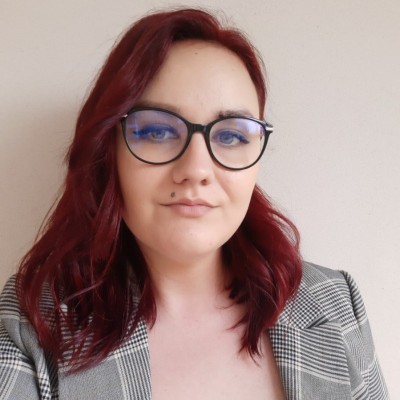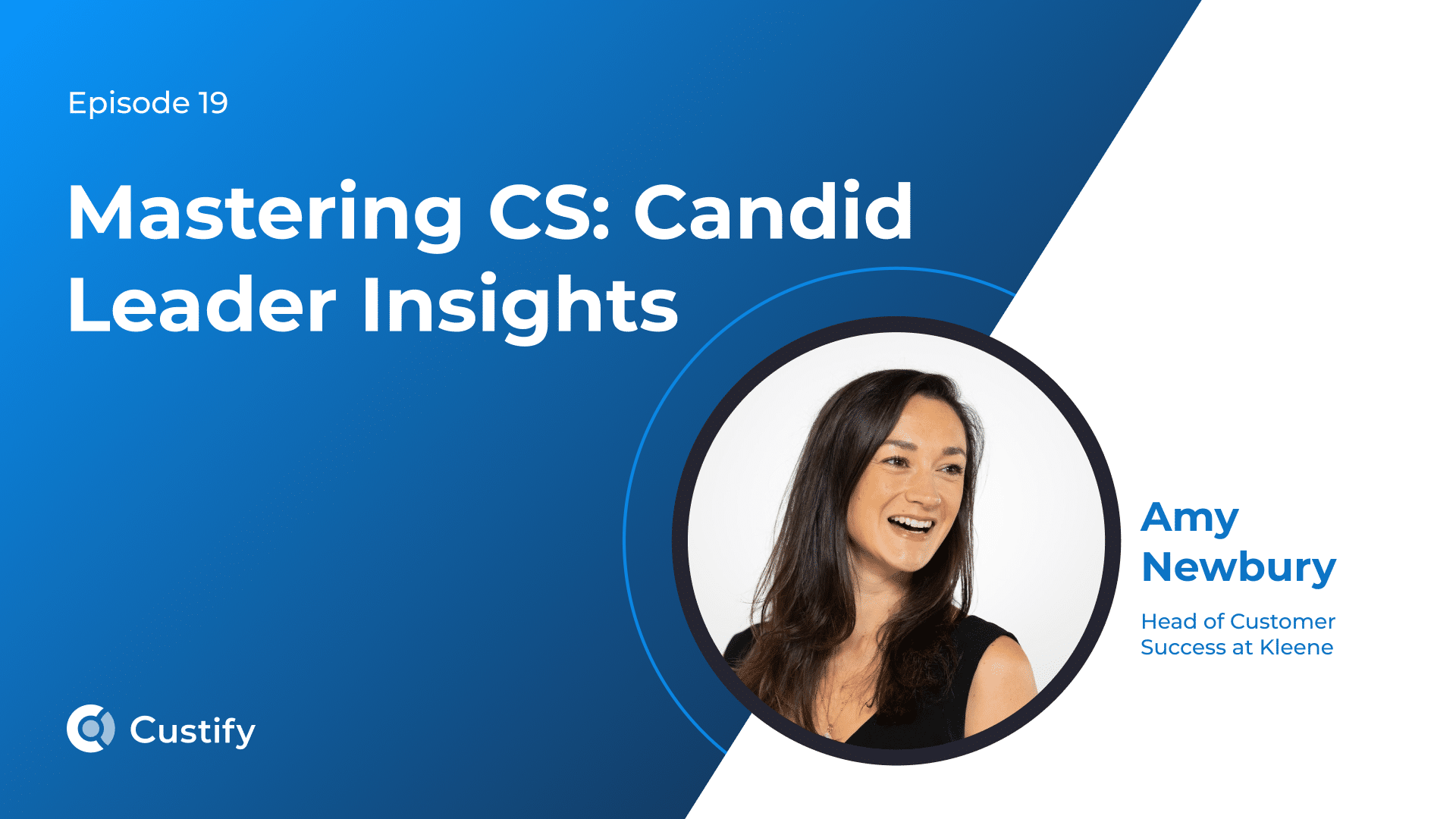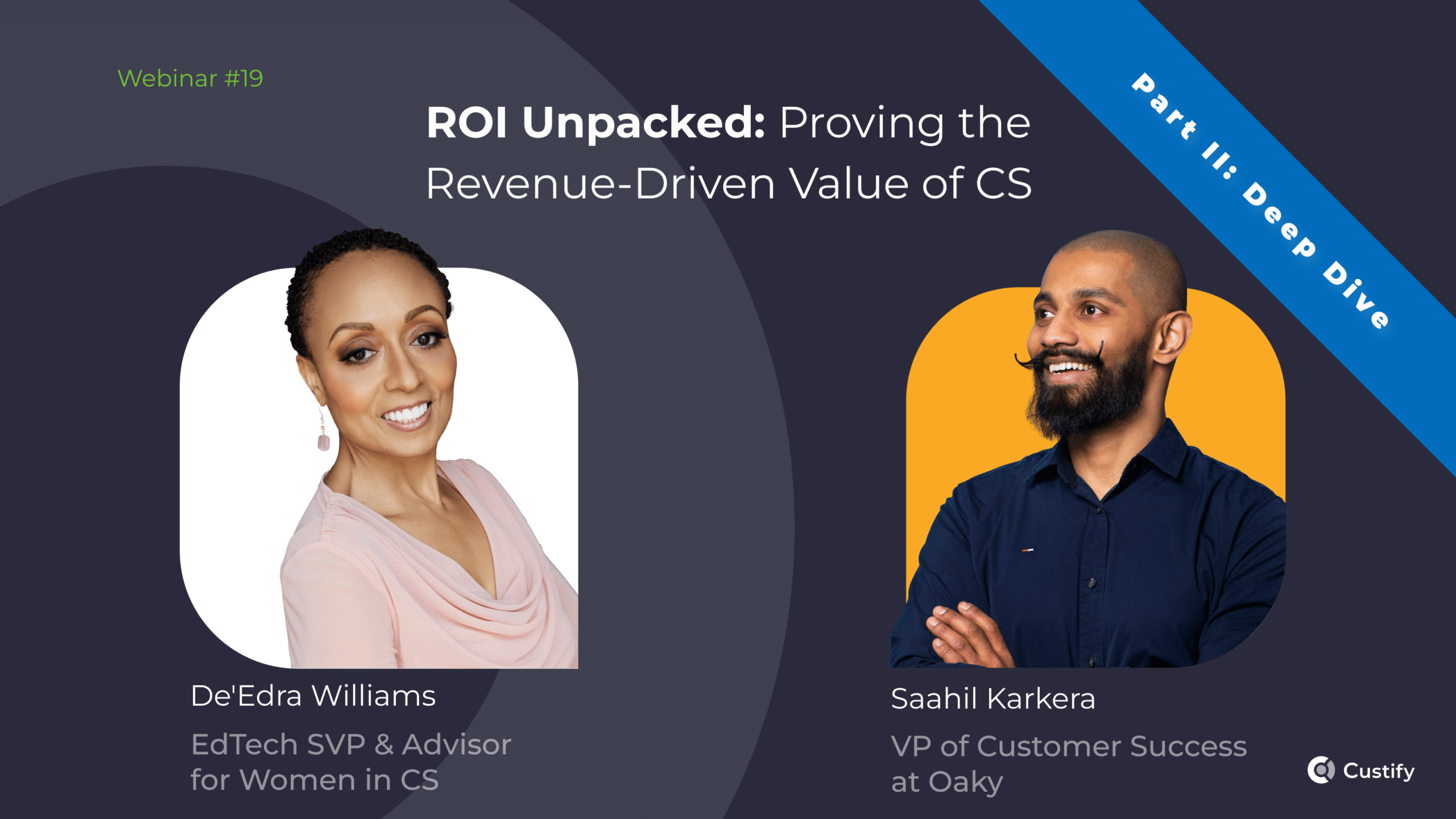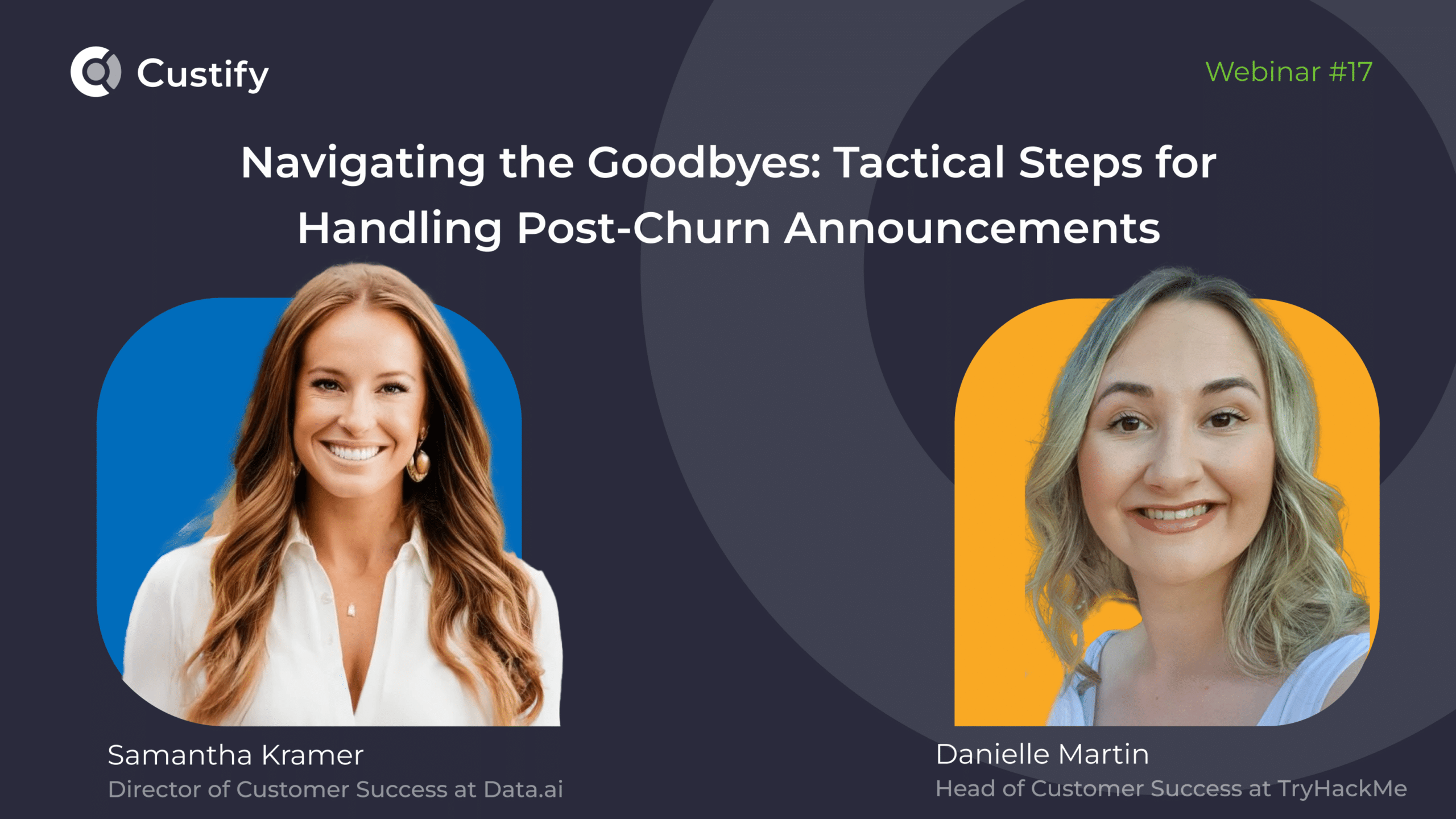We are back with a new episode from our podcast, Mastering CS. In this episode, Irina Cismas, Head of Marketing at Custify, sat down with Bérénice Carrega, Head of Customer Success at rzilient.
Bérénice has had an incredible journey, from public policy in France to leading Customer success in Spain. In this podcast, she shares her experience, the challenges she overcame, and the strategies she implemented.
What You’ll Learn:
- The skills necessary for succeeding in CS
- How to overcome CS challenges
- How a CS organization is structured
- Important KPIs and metrics
- Best customer success playbooks
Key insights and takeaways for CSMs based on the interview:
- Leveraging Limited Resources: In a startup environment with limited resources, it’s crucial to maximize the tools and data available. Focus on quick wins and creative solutions within existing systems, such as CRMs, to gain actionable insights and improve efficiency.
- Importance of Comprehensive Onboarding: A well-crafted onboarding playbook is essential for setting clients up for success. Establish clear expectations from the kickoff call, provide necessary tools and outcomes, and maintain continuous onboarding to ensure client satisfaction and engagement.
- Feedback Loops and Customer Metrics: Regularly collect and analyze both quantitative and qualitative feedback through surveys, platform usage metrics, and early warning signs. This helps in understanding customer satisfaction, stickiness, and areas for improvement.
- Operational Efficiency and Automation: Continuously improve operational efficiency by automating workflows and minimizing manual tasks. This approach not only saves time but also ensures high productivity and better resource management.
- Adapting to Change and Scaling: Be adaptable and open to evolving roles within the organization. As demonstrated in the interview, transitioning from a consultant to a strategic role in customer success highlights the importance of agility and willingness to step out of comfort zones to drive impact.
Podcast transcript
Intro
Irina 00:02
Welcome to Mastering CS- Candid Leader Insights, the podcast where we dive into the world of customer success with industry leaders. I’m your host, Irina Cismas, and today we have a very special guest, Bérénice Carrega, the Head of Customer Success at rzilient. I hope I pronounced it correctly.
Bérénice had an incredible journey from public policy in France to leading Customer Success efforts in Spain. We will be chatting with her about her experience, the challenges she’d faced, and the strategies she’s used to overcome those. So sit back, relax and let’s get started.
Bérénice, welcome and thank you for your participation! Today, I want to start by asking you, How does a French former public policy analyst end up working in Spain as a head of customer customer success?
Bérénice 01:00
Thank you so much, Irina, for inviting me! I’m really glad to be able to share my insights.
To answer your first question, it was pretty natural for a public policy graduate like me to start my career as a consultant in this field. At the time, I didn’t want to specialize in a given industry. I wanted to stay agile and be able to jump from one industry to another. So, I started working on very diverse investment projects, beginning in cybersecurity and then switching to public health. These are very different industries, but I soon faced slow-moving processes, whether from the French bureaucracy or the large consultancy firm with thousands of employees. I was just another consultant among many.
However, I had the opportunity to learn and master key project management concepts from start to finish, and I really enjoyed the client-facing experience, dealing with many different stakeholders. But it soon became clear to me that I would be more fulfilled in a more agile and impactful environment, as I had a hard time seeing the tangible outcomes of my day-to-day work and the projects I was involved in. So, there were two main factors for my decision to move and quit my job.
Firstly, the lack of impact and evolution opportunities in the big corporation. Secondly, I am willing to explore the tech and international environment. So, I stepped out of my comfort zone, quit my secure job, and applied to positions in Spain, particularly in Barcelona, because of its vibrant startup and scale-up scene.
It was a conducive environment for me to reinvent myself and dive into the tech industry startup environment. This is when I joined rzilient, my current company, first as a Customer Success and Project Manager. Within six months, I transitioned to a more strategic role as the Head of Customer Success. This evolution was natural for me because, in my previous experience in public policy analysis and consultancy, I had proven to be adaptable, curious, and goal-oriented. As you may know, Customer Success Managers are often seen as project managers for their clients’ success. There are many similarities in terms of methods and personality traits that you need to succeed in this position.
Skills for Succeeding in Customer Success
Irina 04:08
While you were describing the transition and the journey, you mentioned a lot of a lot of skills. I want to ask you, what do you think were those particular skills that helped you from this transition? What were your assets that helped you better embrace this role?
Bérénice 04:31
Well, I would definitely start by mentioning project management skills, of course, because pretty early on in my professional career, I was in charge of funding complex projects and dealing with a lot of high-level stakeholders and working in cross functional teams. So I really had to prove to be rigorous and goal-oriented in this aspect.
I mentioned that there are a lot of similar steps in the customer journey and in project management.
In general, I’m also a big fan of processes, because, to me, there are like roadmaps in order to guide our customers towards success, and by setting clear expectations and processes from the get go, this is your best shot at making it successful clients.
I also mentioned adaptability and curiosity, being able to quickly learn and grasp what you need to know about a given industry, and last but not least, maybe the analytical and data-driven mindset. I wouldn’t go as far as saying that I’m a numbers person, but I do like a good puzzle. And in this aspect, customer success is all about making it work based on the based on the needs that your that your customer escalates, creating any missing process on the road and throughout the customer lifecycle and journey,
and just giving you the key to adopt a proactive approach instead of just reacting to your customer complaints anyway.
Irina 06:10
How did you actually prepare to become a CSM?
Bérénice 06:16
Well, I really made the most of my onboarding to actually learn by myself with resources that I can find online, but also by shadowing not only my teammates but all the company. Basically, I really wanted to grasp what it meant to deal with the client in my company, not only from the operational aspects, but also from the from other teams standpoint. And I wanted to understand everything about how our business worked, not just my own wall, in a way. So I really took this onboarding seriously. I took notes of everything, and I really wanted to document this onboarding process.
I really considered it to be like a continuous onboarding, just like for clients that you keep on learning and you have to keep questioning any existing process in order to improve it continuously at first, I must admit, I was having a hard time at first with the kind of startup lingo and language because there are a lot of acronyms and concepts that you don’t really learn when you haven’t been to a business, when you haven’t attended a business school, or when you don’t come from the startup environment, so to speak. And I didn’t want to be lost in this ocean of new terms, so I really took it on me to to educate myself and to proactively look for resources to speak to, to relatives who were, who were actually doing lots of different positions in the startup of environments, in order to actually grasp what was at stake.
A typical day as a Head of CS
Irina 08:05
What’s a typical day like for you as a Head of CS at rzilient? I want to start by understanding who your customers are and what challenges they typically face.
Bérénice 08:20
So rzilient is an all-in-one platform for our customers to manage all their IT assets, whether it be hardware or software, including equipment, access, and licenses. We help SMBs and startups scale by giving them the tools and processes for accidental IT owners. In other words, we support those in the company who end up handling IT tasks without necessarily having the expertise or interest in these responsibilities. Our platform allows them to manage all aspects of their company’s IT, from start to finish. They can request new hardware or software, keep track of key metrics, and report to their executives and decision-makers within their company.
We mostly operate in Europe, but also in America. We are proud to be working with companies like 360 Learning, Lifestorm, etc.
We are mostly present in Europe, but we are also opening new markets, not only in France where we have historically developed, but also recently in the UK and Spain.
The main pain points for my day-to-day interlocutors are ensuring that any employee’s laptop is delivered on time and securely during onboarding. Office managers or HR professionals, who often have nothing to do with IT and security, end up being accountable for security compliance within the company, especially with the growing number of startups undergoing security compliance audits like ISO 20k1.
Overcoming CS challenges
Irina 10:37
How do you and your team actually help them overcome those challenges from our CS perspective? What do you actually do?
Bérénice 10:46
We have a huge focus on customer enablement, providing our customer base with the necessary tools and knowledge to leverage our platform and services and achieve the outcomes we set up with them from the start.
We have comprehensive onboarding and continuous training programs. We also utilize a comprehensive knowledge base, including Loom videos for more interactive and personalized content, as well as interactive walkthroughs and tutorials with Toolscribe. Additionally, we offer in-app guidance that we maintain along with the product team.
The key aspect is to provide the admins on our platform with key metrics and actionable APIs, enabling them to report to their executives and shed light on the value we bring to them.
Structuring the CS organization
Irina 11:56
How is your CS organization structured? How has your CS organization evolved since you joined the company? You mentioned that you were initially a CSM and then transitioned to a more strategic role. Please let us know how we are set up, what roles are involved, and where you report. Where does the CS organization sit in the larger organizational chart?
Bérénice 12:25
Yeah, sure. Let me start by saying that I joined the company a year and a half ago, and at the time, it was only the beginning of a dedicated customer success team. Before I joined, it was actually the sales team who were closing deals with prospects and leads, onboarding customers onto the platform, and managing the customer relationship. As the company grew, it became clear that we needed a dedicated team for this. So, two of our salespersons transitioned from sales to customer success, adding an entirely different dimension to the role. This is when I joined the company. I initially stepped in as a Customer Success and Project Manager. From the recruitment process, my role was meant to be quite evolutive and agile based on my professional aspirations and my background in project management.
I proactively shaped my own journey at rzilient. I leveraged my onboarding experience to document the onboarding process for future team members, as the goal was to scale the team and create the conditions for the company to absorb more clients as sales were closing new deals. I really appreciated my company’s openness to this agile approach, which helped me shape my own journey at rzilient. Within six months, I transitioned to a more strategic role by providing insights about our customer base. I became the Head of Customer Success, reporting to the CEO.
Our current team structure has evolved from sales handling the entire customer lifecycle to a more specialized team structure based on the insights we have gathered over the past few months. This has proven to be the most efficient team structure. Our team includes a Senior Customer Success and Account Manager who provides guidance to key accounts and ensures their success and growth. We also have an Onboarding Implementation Specialist and two Customer Care Representatives, one focusing on after-sales support and the other specializing in billing and administrative tasks. Additionally, we have recently recruited a Customer Success Specialist and Project Manager to help me structure the team further and create even more processes.
As the Head of Customer Success at rzilient, I lead this team. In a few words, I ensure that the company’s vision is translated into actionable roadmaps for my team members.
Transitioning from one position to another
Irina 16:01
What are the main roadblocks that you faced when you transitioned from CSM to Head of CS, what were your biggest challenges in the new role? What was the most difficult thing that you had to overcome in this position?
Bérénice 16:22
I think that scaling with limited resources is often cited as one of the main roadblocks. A few days ago, I was reading a Customer Success leadership study which said that more than half of customer success teams had to either downsize or maintain their outcomes last year in 2023. It’s really challenging when you transition to a leadership position to find a balance and manage expectations internally, especially when you are asked to do more with the same or even fewer resources. This aligns with one of our key objectives at rzilient, which is to leverage technology to increase productivity and eliminate manual, low-value tasks through automation and the tools we use daily.
We emphasize the effort versus value metrics, which I often share with my team to help them prioritize their actions in their weekly organization. This ensures that 80% to 100% of their day-to-day tasks actually contribute to achieving the company and team goals.
This approach requires open communication and often involves difficult conversations. While we always want to recruit more people, it’s also an opportunity for us to become more efficient and automate as many processes as possible while maintaining high satisfaction standards.
Main KPIs
Irina 18:25
Speaking about objectives, what are your main KPIs, and how do you keep track of them?
Bérénice 18:25
Yes. So we have four objectives within the team: retention, expansion, productivity and efficiency, and low-cost acquisition.
For the first one, retaining our existing customer base, the goal is to maintain the value perception among our customers. To achieve this, we monitor the net recurring revenue that our customer base brings us and closely track the churn rate. We have also implemented a comprehensive feedback loop through punctual and regular survey campaigns to monitor the customer satisfaction score and the Net Promoter Score (NPS) to assess the degree of customer stickiness and advocacy—whether they will recommend us to other businesses.
The second objective is to continuously improve our operational efficiency, which is crucial in a small startup with limited resources. Our main metric for this is measuring the time to first value—the time it takes for a new customer to realize our worth and how we help them save time, money, etc. We measure this by the length of the onboarding process. The faster and more efficient the onboarding, the more likely a client is to stay within a year. We aim to maximize the value of every touchpoint throughout the client lifecycle, not only during the onboarding phase but also throughout the entire customer journey.
The third objective is to expand the revenue per customer. We focus on two main metrics: the average revenue per customer, which we strive to improve continuously, and the efficiency of our account management playbooks. We monitor the share of upsell discussions that convert to an upsell or cross-sell, leading to increased revenue.
Last but not least, an objective that is also the responsibility of the marketing team is to support the low-cost acquisition strategy of rzilient. Acquiring customers through word of mouth is cheaper than other marketing methods. As the Head of Customer Success, I play a key role in shaping this strategy and ensuring we create a community of satisfied and engaged customers who spread the word about their satisfaction.
We have two ways of monitoring our success in these aspects: the volume of client success stories or testimonials we collect every quarter and the increase in the share of leads that come through referrals and word of mouth.
Preventing churn
Irina 22:05
You have a lot of KPIs at some point, you also mentioned churn. What type of data or insights do you focus on to prevent churn? What’s the most important data point that you are trying to connect?
Bérénice 22:20
An important point to mention from the start is that in a small startup, you don’t have access to as many tools as you would in a larger environment, so you really have to make the most of what is available and manage expectations. This has been a significant challenge.
To be honest, we mostly focus on customer feedback, both quantitative and qualitative. We conduct regular surveys at key milestones in the customer lifecycle, such as quarterly surveys and surveys at the end of onboarding. We also measure the usage of our platform by our clients to assess their stickiness and see the degree to which our product and services have become indispensable for them. We combine these insights with more qualitative ones, such as early warning signs and our knowledge of the clients’ contexts. For instance, we consider if they are experiencing a difficult economic situation or if they are planning to internalize their IT function.
The key takeaway here is not to feel frustrated by the lack of data and to focus on the many quick wins you can achieve, even if you feel like you’re missing some tools or key data. In a small company, when you are not yet mature enough to invest in a comprehensive Customer Success suite of tools, there are still many things you can do within your CRM. I encourage you to be creative and find workarounds to make the most of it. Set up triggers, automate as many workflows as possible to get actionable insights. For example, I wish we had the maturity to compute a very specific customer health score. This may be possible in the near future, but for now, we rely on the tools we have to do so.
Customer success playbooks and automation
Irina 25:06
You mentioned health scores, and at some point, also automation. What was the most successful CS playbook that you’ve built, or, if not in a traditional way, playbook, CS automation that you are relying on?
Bérénice 25:30
I would say definitely the onboarding, the onboarding playbook as I crafted it, based on my own experience, and I really wanted to capitalize on this and this experience to document any missing process. So this includes setting expectations from the get go with with the clients during the kickoff call, setting them for success, introducing the team and providing them with with not only with clear outcomes and incentives for them to to actually, to actually use our products, but also give them the, give them the necessary tools for them to do so.
I mentioned that continuous onboarding was a key aspect also.
And yeah, having, more generally, having, having a feedback loop throughout the customer life cycle to drive project adoption and to gather feedback all along the all along the customer life cycle and the customer journey.
Advice and resources for CS
Irina 26:36
What’s that one piece of advice you wish you knew when building your CS strategy?
Bérénice 26:46
I would say definitely the onboarding playbook, as I crafted it based on my own experience. I wanted to capitalize on this experience to document any missing processes. This includes setting expectations from the start with clients during the kickoff call, setting them up for success, introducing the team, and providing them with clear outcomes and incentives to use our products. Additionally, we equip them with the necessary tools to do so.
I mentioned that continuous onboarding is a key aspect as well. More generally, having a feedback loop throughout the customer lifecycle is crucial. This helps drive project adoption and gather feedback throughout the entire customer journey.
Irina 29:13
Before we wrap up, what’s your favorite book, podcast or webinar that you recommend to our listeners, you mentioned at the beginning that you used to consume a lot of CS resources. What was your favorite?
Bérénice 29:32
I think that my favorite resources are all created by the Director of Customer Success at HubSpot, Daphne Lopez. She shares a lot of insights on LinkedIn and has a podcast called “This is Growth.” What I like about it is that it’s concise, engaging, and actionable. It’s not only useful for building a scalable and proactive customer success strategy as a leader, but she also offers key insights that can be shared with your team. Sometimes these kinds of resources are too high-level and hard to translate into actionable roadmaps, but Daphne’s content is different.
From time to time, I make the most of our weekly team meetings to share a standout post or insight. I encourage my team by saying, “Why not try this approach this week? Let’s implement it and gather next week to see if it worked. If it did, we can make it a regular practice.”
Irina 30:56
I’m also a fan of Daphne. We also had her in one of our webinars. We are also sharing their insights with our audience. So thank you for mentioning her, and thank you so much for sharing your insights and experience with us today, and a big thank you to all of our listeners for tuning in until next time. Stay safe and keep mastering customer success.




